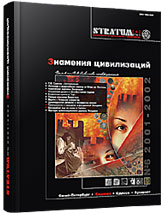Орловское городище в памятниках нумизматики
Orlovka Fortifications in Numismatic Finds
Author(s): Rimma D. Bondar, Svetlana A. BulatovichSubject(s): History, Archaeology, Ancient World
Published by: Издательский дом Stratum, Университет «Высшая антропологическая школа»
Summary/Abstract: The coins finds, obtained as a result of the archeological excavations of the fortification near Orlovka, Odessa region (1963–1992) are analysed in the article. All the coins are kept in the Odessa Archeological museum.Greek coins, exept hoard of electrum Kyzic’s staters (73 ex.), are presented by singular emissions of Istrus and Calltis. Orlovka hoard proves significance cyzicenes as international currency on the coast of the Black Sea.The earlist of the Roman coins are Republican denarii, which had been circulation hear possibly after the raising of the Roman fortress.Almost haft of the 13 coins of the 1st c. A. D. Are related to the time of the Julio-Claudian dynasty. As well as Republican denarii, these coins are almost unknown in the area between the Danube and the Dniestr. Along with other archeological finds, Orlovka coins allow to consider the Roman fortress building belonging to the latter half of the 1st c. The circulation of the coins of the 1st c. A. D., as well as Republican denarii, did not go outside the fortress. In that way, the composition of money circulation in Orlovka during the initial period was a unique phenomenon for the area between the Lower Danube and the Dniestr.As well as in the rest of the territory East of the Lower Danube, the peak of the incoming of Roman coins to Orlovka is related to the IInd c. A. D. (20 pieces).The IIIrd c. A. D. Is only represented by the latest coins from Orlovka did not go beyond the bounds of the second decade of the IInd c. A. D. (times of Caracalla and his wife Plautilla), and the destraction of the fortress due to the fire is clearly found by the excavations, the end of the fortress existence can be connected with the Carpians’ assault.Byzantine coins refer to the first half of XI century and are possibly connected with population of the Balkano-Danubian culture.
Journal: Stratum plus. Археология и культурная антропология
- Issue Year: 2002
- Issue No: 6
- Page Range: 171-182
- Page Count: 12
- Language: Russian
- Content File-PDF

